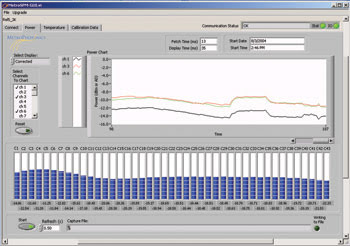Dr. Paul Jay, Intelligent Photonics Control Corp.
Accommodating the spreads of component characteristics in electro-optic assemblies is one of the biggest challenges facing manufacturers today. This applies to test instruments, telecom equipment, fiber lasers and miniature spectroscopy units. Traditionally, each subcomponent is carefully calibrated over its full operating range. Operators are then able to adjust the operating points to optimize the overall performance of the finished assembly. Manual adjustments are not workable, however, when companies face volume deliveries.
Intelligent Photonics Control Corp. has developed a compact platform that automatically calibrates individual optical components (sources, detectors, attenuators) and that provides signal processing algorithms that store and act on the calibration data. It also can be programmed to deliver responses in a required range, through easy-to-use interfaces with pull-down menus. The 33 × 33-mm control platform combines four analog inputs, two to three analog outputs, a digital signal processing engine and communications ports for interfacing to an IP address. Operating software comes with the platform and can be configured to control a wide variety of functions (optical amplifiers, performance monitors, tunable lasers, spectrometers). Also included are accessible user interfaces adapted for development engineering (setup) as well as for end-customer ease of use (see figure).

This screen capture shows the user interface for the controller managing a 43-wavelength optical performance monitor manufactured by MetroPhotonics Inc.
Automatic calibration
Calibration of the bank of up to 48 detectors is done automatically to optimize performance. The controller enables a wide dynamic range, high accuracy and fast response. All of the calibration data is stored in local memory. The user can direct the operation of the optical performance monitor employing the menus provided, as well as choose which channels to display and set alarm thresholds. A useful feature in this application is the ability of the software to accurately calibrate near-neighbor interactions between adjacent detectors that are 100 GHz (about 0.8 nm) apart and to correct for these, providing precise channel power readings.
Although this particular measurement is used extensively in telecommunications applications, the per-channel resolution illustrates how effectively this type of controlled optics could enable close discrimination of optical lines in some other applications. An example is infrared spectrometry, where compact size and rapid accurate response open up market opportunities for applications such as biological monitoring and security.
Traditional spectrometers use a prism- or grating-based approach to separate the component wavelengths of a particular optical signal. However, the associated physical size and rigid optical alignment requirements impose constraints on form factor and portability. With the advent of integrated optical demultiplexing functions that were developed for infrared wavelengths used in the telecommunications industry, a single optical chip on the order of 1 to 2 cm2 can resolve subnanometer wavelength increments in a single operation, without the need for mechanical sweeping technology.
This opens the way to handheld units that can be programmed to recognize individual wavelengths as well as characteristic signatures of wavelength combinations, such as might be detected in absorption samples of biological specimens. These specimens can represent biomedical samples, such as dissolved alcohol molecules, or point-of-use detection for potential security threats, such as undesirable additives in potable water sources.
In conjunction with the integrated optics capability, a comprehensive control platform enables calibration, range setting, crosstalk and spectral correction, temperature control/compensation and, especially, response recognition to be combined into a single unit, also on the scale of a handheld device. This compact functionality responds to growing demands in point-of-care health monitoring as well as for domains such as homeland security, food processing and other cases where immediate-response chemical analysis is valued.
Managing multiwavelength optical source technology is a specific test and measurement application for the controller. Multiwavelength laser technology from Peleton Photonic Systems of Ottawa can be used to produce 40 or 80 DWDM channels locked to the ITU grid. Applications include reconfigurable optical add/drop multiplexer, amplifier and optical performance monitor testing. By exploiting sophisticated optical and electronic domain processing, such a source can be made the size of a laptop computer, offering considerable cost and space savings compared with conventional distributed-feedback-array solutions. The Peleton device, which is being sampled by customers, relies on advanced control electronics for thermal management and current control of lasers, as well as on amplifier and wavelength locking.
Remote troubleshooting
Other features that can be managed by system-on-a-chip controllers include thermal characterization and stabilization of functions within an optical unit, such as lasers, detectors and fiber coils. The ability to monitor and log variations in operating conditions or user settings provides a type of black-box flight recorder, which can be helpful for troubleshooting instrument problems or failures.
Memory capability within the control platform is used to store calibration curves and related information such as alarm thresholds. It is also easy to program this capability to record events and instructions affecting the optical function, providing a source of historical information that can be of great value in the event of a perceived failure or modification of device behavior.
As an example, optical amplifier manufacturers have suffered major inconvenience arising from the premature failure or degradation of pump lasers and, in some cases, have been obliged to deal with large numbers of returned (apparently failed) units, as many as 50 percent of which, upon examination, proved to be “no-fault-found.” The cost of retrieving and testing these units could have been saved by using remote capability to examine the operational status of the device in question, and perhaps to reinstate desired operating settings that had been inadvertently modified by another intervention. In other cases, a failure could be traced to a signal overload registered in the alarm log and stored in local memory of the controller.
The inclusion of interfaces in Ethernet or other remote communications protocols also makes it easy to establish a remote connection to customer equipment in the field, potentially minimizing unnecessary shipments for service calls.
Meet the author
Paul Jay is chief technical officer at Intelligent Photonics Control Corp. in Kanata, Ontario, Canada; e-mail: [email protected].